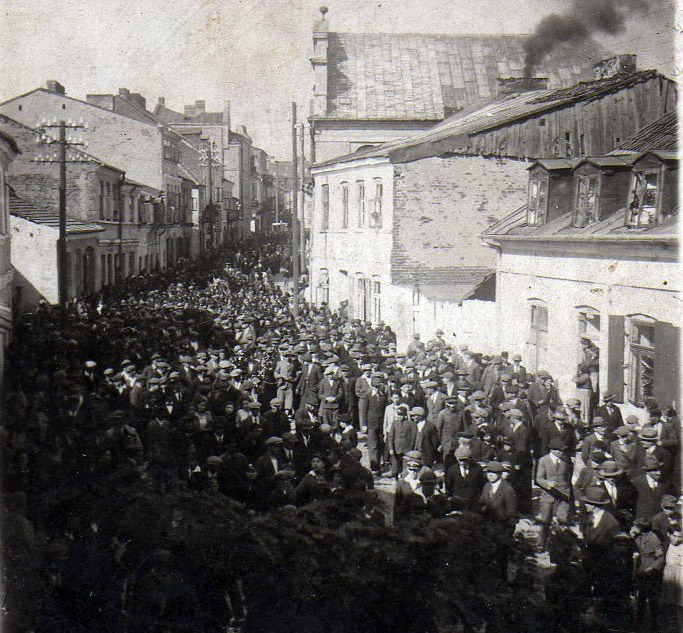 |
||
 |
HISTORY OF PLONSK |
|
The princes of Masovia encouraged the settlement of the Jews to help the develop the economy of the town, although this aroused the jelousy of the polish merchants, and consequently, Jewish activity was later restricted by various decrees. Town in Warszawa Province (Warsaw), in east central Poland. A Jewish settlement existed from 1446. In 1677 King John III Sobieski prohibited all jewish commerce on market days, with the only exception of the sale of kosher meat. In spite of the restrictions, the number of Jews increased, as did their importance in the town. In 1887 Jews owned most of the houses and the shops; they dealt in the wholesale trade of cereals and owned brandy distilleries, beer breweries, underwear factories, etc. They were also engaged in tailoring and the fur trade, exporting goods to the interior of Russia. Jews numered 2,801 in 1808; in 1910 they numered 7,665 (64% of the population), and in 1939 there were an estimated 8,200 Jews in the town of Plonsk. Really, the history of Plonsk goes over 600 years although colonisation in this land dates back to the 6th-7th century, as was documented by archaeological research conducted on so-called Kawalowski’s Mount in the year 1975-1980. Exhibits are kept at the District Museum in Ciechanow. It is planned to tranport them to Plonsk, when the Museum of Plonsk Land is opened. The best way to familiarise oneself with the history of Plonsk, visiting the Town’s History Documentation Room, that gathers information and actively looks for all information on the town and its residents. In the center of Plonsk, in Plocka Street, there is the Catholic Church of St. Archangel Michael. Beside it one can see the historical building of the former monastery of the Calced Carmelites. Both these buildings are occupied by public intitutions. The Church and the Monastery, originaly wooden, were funded in 1417 by Mazovian Duke Siemowit IV and his wife Alenksandra, sister of the King Ladislaus Jagiello. In 1462 both buildings were converted with the use of bricks. The original foundation charter of the buildings has not been preserved. The Jewish community became particulary important after the Swedish deluge. Jews prospered when King Michel Kory Wisniowiecki in 1670 granted Jews the privilege of building houses and synagogues and brewing beer. The Great Synagogue of Plonsk, dating from the early 17th century and its Ark was a work of art. During the 15th century the Jewish community was under the guardianship of Plock, the leading community of Masovia. With the organization of the Council of the Four Lands, it was subordinated to the community of Ciechanow, but due to its expansion it eventually became and independent community. The Jews of Plonsk participated in the Polish Revolt of 1863. Solomon Posner, one of the commanders of the Plonsk company, was killed in battle. The town developed significant in the 16th century, but already in the 17th.century, an economic regression started-out of 130 houses, only 21 were preserved. Due to dangerous fires and disasters that Poland suffered during the period of its partition and national liberation impulses, Plonsk lost its importance. Tenement houses preserved in the Market Square and its immediate vicinity are reminiscent town’s 19th century history. During the 19th century the community administration was under the influence of the mitnaggedim, even thought the courts of the zaddikim (especially that of Gur) exerted considerable influence on the Jews of the shtetl. In 1865 a society named Doreshei ha-Torah ve-ha-Hokhman was founded by the maskilim, offering lectures on Jewish subjects. In the 20th century the influence of the maskilim and the Zionists rose were very much.The community supervised the activities of the relief and educational institutions. Jews were elected both the provincial and municipal councils. At the municipal council elections of 1927, out of the 23 delegates, 13 were Jews. In addition to the religious, educational and cultural institutions of the town, there were also societies for the propagation of Jewish and general education. In 1910 the Ha-Or society was established, having been authorized by the Russian authorities to propagate Jewish and general education. Zionist societies were also very active in promoting Hebrew language and culture. In this Shtetl of PLONSK, the Zionist Organization wielded considerable influence. It was quite evident in daily life, and especially apparent at the time of the elections to the Zionist Congresses. At the outbreak of World War II there were about 6,000 Jews in Plonsk but some others estimated the number as 8,200. The German army occupied the town in September of 1939. Some Jewish men were sent to the forced-labor camp of Nosarzewo and Jewish women to the forced labor camp in Spierc. Few of them survived. A closed ghetto was established in May 1941. The Jewish Community was liquidated when 12,000 Jews from Plonsk and the vicinity were sent to Auschwitz in four transports between November 1st and December 5th 1942. After the war, the Jewish community was not reconstituted. Organizations of former residents of Plonsk are active in Israel, the United States, and Argentina. The history of Plonsk includes the tradition of the Jewish nation.
|
||
Plonsk prior to the 1939 German invasion
|
||
This picture shows Jewish persons running when the germans wanted to transport them to the Camps.
|
||
|
Gallows in the Ghetto of Plonsk |
||
| Map of the Ghetto of Plonsk and vicinities. As you can see, there is a gallows in the drawing. The Synagogue was inside the Ghetto. It take a great portion of the Shtetl. | ||
| © Copyright 2008-9 Ana Nutta | ||

 Jews escape from the
nazis in Plonsk
Jews escape from the
nazis in Plonsk

